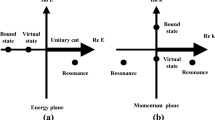Abstract
Processes in which the atomic nucleus participates are either nuclear reactions or nuclear transformations (decay). These processes will be described in three sections. In the first section, atomic structure, general properties of nuclei, and types of radiation are discussed. The second section discusses nuclear reactions and radioactivity. The last section is a review of interactions of nuclear radiations with matter.
Access this chapter
Tax calculation will be finalised at checkout
Purchases are for personal use only
Preview
Unable to display preview. Download preview PDF.
Similar content being viewed by others
References
R. D. Evans, The Atomic Nucleus, McGraw-Hill, New York (1955).
D. L. Livesey, Atomic and Nuclear Physics, Blaisdell International Series, Blaisdell, Waltham, Mass. (1966).
D. J. Hughes and R. B. Schwartz, Neutron Cross Sections, Brookhaven National Laboratory, Report No. BNL-325 (2nd ed.), plus supplements, (1958).
H. W. Schmitt, W. E. Kiker, and C. W. Williams, Precision measurements of correlated energies and velocities of 252 98Cf fission fragments, Phys. Rev. 137:B837 (1965).
C. M. H. Smith, Nuclear Physics, Pergamon Press, Oxford (1965).
C. M. Lederer, J. M. Hollander, and I. Perlman, Table of Isotopes, John Wiley, New York (1968).
B. W. Hoffman and S. B. Van Camerik, A table and method for determining the true time representing a count rate observed in radionuclear counting, Anal. Chem. 39:1198 (1967).
G. R. White, X-ray Attenuation Coefficients from 10 keV to 100 MeV, National Bureau of Standards (U.S.), Report No. 1003 (1952).
J. S. Eldridge, Guide to Activation Analysis (W. S. Lyon, Sr., ed.), Van Nostrand, Princeton, New Jersey (1964).
W. J. Price, Nuclear Radiation Detection (2nd ed.), McGraw-Hill, New York (1964).
General
A. Beiser, Concepts of Modern Physics (1st ed. revised), McGraw-Hill, New York (1965).
R. M. Eisberg, Fundamentals of Modern Physics, John Wiley, New York (1965).
I. Kaplan, Nuclear Physics, Addison-Wesley, Reading, Mass. (1963).
D. J. Carswell, Introduction to Nuclear Chemistry, Elsevier, Amsterdam (1967).
G. Friedlander, J. W. Kennedy, and J. M. Miller, Nuclear and Radiochemistry (2nd ed.), John Wiley, New York (1964).
R. P. Gardner and R. L. Ely, Radioisotope Measurement Applications in Engineering, Reinhold, New York (1967).
Author information
Authors and Affiliations
Editor information
Editors and Affiliations
Rights and permissions
Copyright information
© 1973 Plenum Press, New York
About this chapter
Cite this chapter
del Pozo, P.M. (1973). Basic Theory of Nuclear Processes. In: Krugers, J. (eds) Instrumentation in Applied Nuclear Chemistry. Springer, Boston, MA. https://doi.org/10.1007/978-1-4684-1953-5_1
Download citation
DOI: https://doi.org/10.1007/978-1-4684-1953-5_1
Publisher Name: Springer, Boston, MA
Print ISBN: 978-1-4684-1955-9
Online ISBN: 978-1-4684-1953-5
eBook Packages: Springer Book Archive




